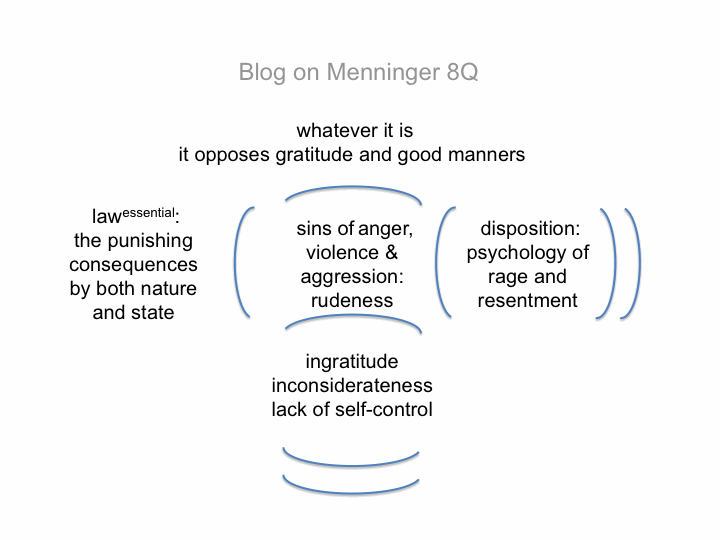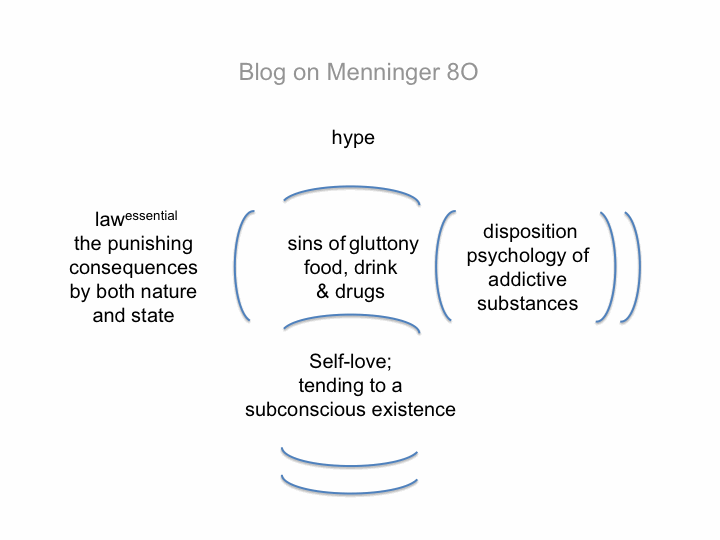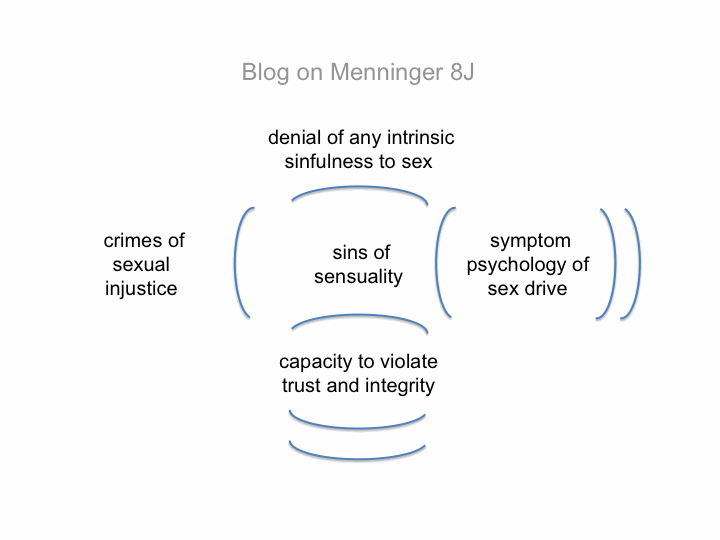Thoughts on Whatever Became of Sin? By Karl Menninger MD (1973) 8P
Menninger went on to the “sins of anger, violence and aggression”.
On the horizontal axis of lawessential(sin(disposition)), the dispositions are “the psychologies of rage and resentment”. The sin itself is often manifested as rudeness. The lawessential includes both a judicial system of plea-bargaining & mandatory prison time as well as a community of damaged opportunistic individuals.
When “sin” is replaced by “political incorrectness”, then lawessential condones acts of rudeness, violence and aggression against individuals deemed “incorrect”.
On the vertical axis of thinkgroup(sin(consciencelacking)), Menninger mentioned that rudeness, violence and aggression are made possible by attitudes of ingratitude, inconsiderateness, and lack of self-control. He also noted the alternate to thinkgroup was the thinkdivine of gratefulness and good manners.
Since Menninger was unaware that he stood for both Progressives and Christians, he was not in a position to see how Progressive thinkgroup contrasted with Christian thinkdivine. Consistent with prior blogs, Progressive thinkgroup tells the believer what she wants to hear: Rudeness, violence and aggression express righteous anger, not bad manners.
Cryptotheological formulae explain the righteousness.
Thoughts on Whatever Became of Sin? By Karl Menninger MD (1973) 8N
What about the vertical axis for gluttony – food, drinks and drugs?
Menninger associated gluttony to a destructive self-love, tending towards a “subconscious existence”. This certainly fits the “loss of conscience” that makes “sins of gluttony possible”.
Menninger did not explore the thinkgroup that puts the sins of food, drinks and drugs into context. But, like most Progressives, he made fun of quaint religious traditions of thinkdivine that forbid coffee, tea and beer.
But I have an example: Consider that great propagandizer of self-love and subconscious existence: American television (any time, from 1960 to 2012). TV thinkgroup romanticized all types of addictions, including the most important one: addiction to itself.
So for TV gluttony, the vertical axis might be “television hype for the goodness of its own programming and ads(sin of being a couch potato(destructive self love tending toward a subconscious existence))”.
Now, what about the Gluttony for Entitlements by the Central Government?
Thoughts on Whatever Became of Sin? By Karl Menninger MD (1973) 8M
Let us turn to the next set of sins in Chapter 8: “Gluttony – Food, Drinks and Drugs”.
What makes the “sins of gluttony” possible? Pleasurable substances plus the psychology (or neurophysiology) of addiction make good candidates for “symptoms”.
What puts the “the sins of gluttony” into context? The “crimes” of obesity, intoxication, drunkenness and addiction made good candidates for “crimes”.
Again, we find opportunity to expand the concept of “crime”. Menninger limited “crime” to the jurisdiction of the state. “Crime” could also include the punishing natural consequences of the sin. Thus, the word “crime” might be replaced by a more general term, such as lawnature or lawessential.
Similarly, Menninger’s idea of “symptom” was “something that would be subject to improvement by a psychoanalyst or mental health worker”. We can expand this concept by substituting the word “disposition” for “symptom”.
The horizontal axis of “lawessential(sin(disposition))” would be, for this set of sins, “the punishing consequences by both nature and state(sins of gluttony(the psychology or neurophysiology of pleasurable substances)).
Thoughts on Whatever Became of Sin? By Karl Menninger MD (1973) 8L
Before modernism, the horizontal “crime(sin(symptom))” might be expressed – er, maybe ‘repressed’ – as “this is reprehensible(sin of sensuality(the temptations of lust).
The vertical “thinkdivine(virtue(consciencefree))” might be – perhaps – “divine judgment(self-denial(avoid the vice of lust))”.
The two of the poles of “divine judgment” and “this is reprehensible” must have put a damper on the sins of sensuality. Believers worked hard to avoid both “tempting thoughts” (which might correspond to “symptom”) and “the vice itself” (which would correspond to a free will decision to commit the deed).
Menninger was on target by nominating St. Anthony to be the poster child of this premodern mandala.
There is a certain beauty to the Temptations of St. Anthony. “Divine judgment” told St. Anthony ‘something’ that he did not want to hear, and yet, he could not reject that voice?
This beauty precisely opposes the beauty of the serpent in An Archaeology of the Fall, a serpent that captures the nature of thinkgroup: The serpent tells you what you want to hear.
Thoughts on Whatever Became of Sin? By Karl Menninger MD (1973) 8K
Substitute “political incorrectness” in for “the sins of sensuality” (in the previous blog) to get a flavor of one of the many atrocities that Menninger was unconsciously hoping to avoid: Sexual injustice is a crime only if it is politically incorrect – or worse – involves a person deemed “politically incorrect”.
Perhaps, Portnoy (of Portnoy’s Complaint) was not the poster-child of modernism in this regard.
Can you imagine who might be?
Thoughts on Whatever Became of Sin? By Karl Menninger MD (1973) 8I
How would Menninger’s mandala apply to lust, fornication, adultery and pornography?
With modernism, the horizontal axis, “crime(sin(symptom))” could be “crimes of sexual injustice(the sins of sensuality(the psychology of the sex drive))”.
Note how the term “crimes of sexual injustice” encompass more than anything that would be in the books of modern law. They include breaking hearts.
The vertical axis of “thinkgroup(sin(consciencelacking))” might be the “denial of the intrinsic sinfulness of anything connected with sex(sins of sensuality(the capacity to violate trust and integrity))”.
Three of the four poles are theoretically “liberating”: “the psychology of the sex drive”, “the capacity to violate trust and integrity”, and “denial of any intrinsic sinfulness to sex”.
These liberations are countered by “crimes of sexual injustice”.
The liberations are “social”. The injustice is “cosmic”.
Thoughts on Whatever Became of Sin? By Karl Menninger MD (1973) 8H
Now, let us consider the next section of Chapter 8: “The Sins of Sensuality – Lust, Fornication, Adultery and Pornography”.
Before modern awareness, portrayals of sex were considered immoral, reprehensible, and anathema.
OK, it was bigger than that.
Even thoughts about sex (totally imaginary private portrayals, so to speak) were considered immoral, reprehensible, and anathema. St. Anthony struggled. So did Augustinian monks and nuns.
For centuries, “being good” meant sexual restraint, denial and suppression – with certain caveats depending on one’s elite status.
But somehow, the sexual act survived. Otherwise, we would not be here.
In the modern era, psychoanalysts attacked the hypocrisy of “denouncing sexual expression” while at the same time practicing the act, including adultery and masturbation”.
Today, the trend is to deny any intrinsic sinfulness in regards to sex, despite the fact that modern sex games may be intentionally hurtful, destructive or predatory.
Better perhaps, to have an unbroken heart, like the companion to Christian, the hero of Pilgrim’s Progress. Her name was Faithful. She had integrity. She could be trusted.



